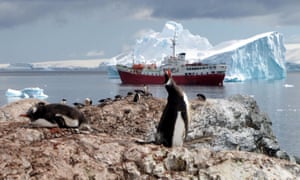Extract from The Guardian
Sea ice around Antarctica
has shrunk to the smallest annual extent on record after years of
resisting a trend of manmade global warming, preliminary US satellite
data has shown.
Ice floating around the frozen continent usually melts to its smallest for the year towards the end of February, the southern hemisphere summer, before expanding again as the autumn chill sets in.
This year, sea ice extent contracted to 883,015 sq miles (2.28m sq km) on 13 February, according to daily data from the US National Snow and Ice Data Center (NSIDC).
That extent is a fraction smaller than a previous low of 884,173 sq miles recorded on 27 February 1997 in satellite records dating back to 1979. Mark Serreze, director of the NSIDC, said he would wait for a few days’ more measurements to confirm the record low.
“But, unless something funny happens, we’re looking at a record minimum in Antarctica,” he told Reuters. “Some people say it’s already happened. We tend to be conservative by looking at five-day running averages.”
In many recent years, the average extent of sea ice around Antarctica has tended to expand despite the overall trend of global warming, blamed on a build-up of greenhouse gases in the atmosphere, mainly from burning fossil fuels.
People sceptical of mainstream findings by climate scientists have often pointed to Antarctic sea ice as evidence against global warming. Some climate scientists have linked the paradoxical expansion to shifts in winds and ocean currents.
“We’ve always thought of the Antarctic as the sleeping elephant starting to stir,” Serreze said. “Well, maybe it’s starting to stir now.”
World average temperatures climbed to a record high in 2016 for the third year in a row. Climate scientists say warming is causing more extreme days of heat, downpours and is nudging up global sea levels.
At the other end of the planet, ice covering the Arctic Ocean has been at repeated lows in recent years.
In the northern winter, sea ice expands and is at its smallest extent for mid-February, at 5.38m sq miles.
Ice floating around the frozen continent usually melts to its smallest for the year towards the end of February, the southern hemisphere summer, before expanding again as the autumn chill sets in.
This year, sea ice extent contracted to 883,015 sq miles (2.28m sq km) on 13 February, according to daily data from the US National Snow and Ice Data Center (NSIDC).
That extent is a fraction smaller than a previous low of 884,173 sq miles recorded on 27 February 1997 in satellite records dating back to 1979. Mark Serreze, director of the NSIDC, said he would wait for a few days’ more measurements to confirm the record low.
“But, unless something funny happens, we’re looking at a record minimum in Antarctica,” he told Reuters. “Some people say it’s already happened. We tend to be conservative by looking at five-day running averages.”
In many recent years, the average extent of sea ice around Antarctica has tended to expand despite the overall trend of global warming, blamed on a build-up of greenhouse gases in the atmosphere, mainly from burning fossil fuels.
People sceptical of mainstream findings by climate scientists have often pointed to Antarctic sea ice as evidence against global warming. Some climate scientists have linked the paradoxical expansion to shifts in winds and ocean currents.
“We’ve always thought of the Antarctic as the sleeping elephant starting to stir,” Serreze said. “Well, maybe it’s starting to stir now.”
World average temperatures climbed to a record high in 2016 for the third year in a row. Climate scientists say warming is causing more extreme days of heat, downpours and is nudging up global sea levels.
At the other end of the planet, ice covering the Arctic Ocean has been at repeated lows in recent years.
In the northern winter, sea ice expands and is at its smallest extent for mid-February, at 5.38m sq miles.

No comments:
Post a Comment